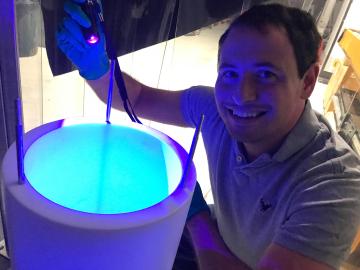
Filter News
Area of Research
- (-) Energy Frontier Research Centers (1)
- (-) Neutron Science (39)
- (-) Sensors and Controls (1)
- (-) Supercomputing (123)
- Advanced Manufacturing (2)
- Biology and Environment (70)
- Biology and Soft Matter (1)
- Building Technologies (1)
- Computational Biology (1)
- Computational Engineering (3)
- Computer Science (15)
- Electricity and Smart Grid (3)
- Energy Science (99)
- Functional Materials for Energy (1)
- Fusion and Fission (11)
- Fusion Energy (8)
- Isotopes (2)
- Materials (90)
- Materials for Computing (14)
- Mathematics (1)
- National Security (37)
- Nuclear Science and Technology (15)
- Nuclear Systems Modeling, Simulation and Validation (1)
- Quantum information Science (7)
News Topics
- (-) Advanced Reactors (2)
- (-) Computer Science (99)
- (-) Coronavirus (19)
- (-) Cybersecurity (9)
- (-) Grid (6)
- (-) Nanotechnology (20)
- (-) Physics (17)
- 3-D Printing/Advanced Manufacturing (10)
- Artificial Intelligence (40)
- Big Data (23)
- Bioenergy (14)
- Biology (16)
- Biomedical (28)
- Biotechnology (2)
- Buildings (4)
- Chemical Sciences (7)
- Clean Water (2)
- Composites (1)
- Critical Materials (3)
- Energy Storage (14)
- Environment (29)
- Exascale Computing (26)
- Fossil Energy (1)
- Frontier (33)
- Fusion (2)
- High-Performance Computing (44)
- Hydropower (1)
- Isotopes (2)
- Machine Learning (17)
- Materials (28)
- Materials Science (33)
- Mathematics (2)
- Microscopy (8)
- Molten Salt (1)
- National Security (8)
- Neutron Science (122)
- Nuclear Energy (7)
- Partnerships (1)
- Polymers (3)
- Quantum Computing (20)
- Quantum Science (30)
- Security (8)
- Simulation (16)
- Software (1)
- Space Exploration (5)
- Summit (43)
- Transportation (10)
Media Contacts

Using complementary computing calculations and neutron scattering techniques, researchers from the Department of Energy’s Oak Ridge and Lawrence Berkeley national laboratories and the University of California, Berkeley, discovered the existence of an elusive type of spin dynamics in a quantum mechanical system.

Scientists have found new, unexpected behaviors when SARS-CoV-2 – the virus that causes COVID-19 – encounters drugs known as inhibitors, which bind to certain components of the virus and block its ability to reproduce.

A method developed at Oak Ridge National Laboratory to print high-fidelity, passive sensors for energy applications can reduce the cost of monitoring critical power grid assets.

Twenty-seven ORNL researchers Zoomed into 11 middle schools across Tennessee during the annual Engineers Week in February. East Tennessee schools throughout Oak Ridge and Roane, Sevier, Blount and Loudon counties participated, with three West Tennessee schools joining in.

To better understand the spread of SARS-CoV-2, the virus that causes COVID-19, Oak Ridge National Laboratory researchers have harnessed the power of supercomputers to accurately model the spike protein that binds the novel coronavirus to a human cell receptor.

The U.S. Air Force and Oak Ridge National Laboratory launched a new high-performance weather forecasting computer system that will provide a platform for some of the most advanced weather modeling in the world.

The COHERENT particle physics experiment at the Department of Energy’s Oak Ridge National Laboratory has firmly established the existence of a new kind of neutrino interaction.

Since the 1930s, scientists have been using particle accelerators to gain insights into the structure of matter and the laws of physics that govern our world.

A new tool from Oak Ridge National Laboratory can help planners, emergency responders and scientists visualize how flood waters will spread for any scenario and terrain.

Six scientists at the Department of Energy’s Oak Ridge National Laboratory were named Battelle Distinguished Inventors, in recognition of obtaining 14 or more patents during their careers at the lab.


